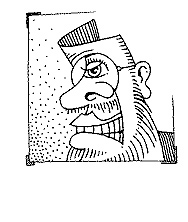I’ve made entries before that allude to my progressive vision problem, but I’ve only now decided to formally record some of my experiences during this new year, when I undertake a therapeutic course of action. While learning about this disorder—a form of misalignment generally known as strabismus—I may need to correct some of the information conveyed, as I gain greater or more specific knowledge. At first, I recall noticing an odd head position and disturbing look in my eyes when I closely examined photos of myself. Initially I could dismiss it as an aberration, or comfortably deny that anything meaningful was indicated. Eventually, I came to accept it as my “pirate eye,” and began to avoid looking at others with a leftward glance, which seemed to bring the misalignment into play. Joan mentioned her optometrist to me, but I wasn’t prepared to seriously tackle the situation. By and by, more realizations that the condition was getting worse convinced me I could no longer put off the idea of professional intervention. Dr. Graebe turned out to be a highly capable diagnostician and engaging clinician. He said that I had already lost 60% of my depth perception, with a deficient ability to process uncoordinated binocular movements. Every symptom I described seemed to just reinforce the obvious for him, and I was mildly surprised that I didn’t have some unique or difficult to define condition. And so he prescribed “vision therapy,” based on the awareness that my root problem is not muscular, but involves the brain’s ability to make sense of neurological input from two organs—our source of three-dimensional vision. In addition to setting up an appointment with the Vision and Learning Center, he urged me to read Susan Barry’s Fixing My Gaze. I’m sure it’s not unusual for a person with a health challenge to discover that his or her malady has been ably explained by an author who has faced the same situation in life. Although I still don’t understand the full implications of taking on the discipline of vision therapy, starting the book has triggered numerous memories and personal observations about my sensory experiences since childhood. Dr. G had been particularly struck by my statement that I knew from an early age I was a two-dimensional thinker, preferring the flat surface over volumetric or architectural forms. It caused me to think about whether I have ever possessed “normal” depth perception. For the longest time, foreshortening has bedeviled me as an artist. I’ve always been a slow reader, never been a good driver, nor been favorably inclined to certain eye-hand motor skills, even though it’s clear I had a natural manual dexterity from the beginning. As a marksman, I excel at single-eye target shooting, but ask me to hit something on the move with a shotgun and the results prove embarrassing.  Saddest of all is when I realized that the awe of star-gazing had slipped away, as my ability to perceive the dimensionality of the night heavens declined. The optimistic hope for improvement, given the functional plasticity of brain neurons, is emphasized by both Susan Barry, Dr. G., and Debra (my therapist). I accept that, in spite of having no comprehension of the difficulties that lie ahead, or how “one must learn to align the eyes and fuse their images, while unlearning the unconscious habit of suppressing vision, which has been occurring perhaps for decades,” or how therapy “requires high motivation and self-awareness, as well as enormous perseverance, practice, and determination.”
Saddest of all is when I realized that the awe of star-gazing had slipped away, as my ability to perceive the dimensionality of the night heavens declined. The optimistic hope for improvement, given the functional plasticity of brain neurons, is emphasized by both Susan Barry, Dr. G., and Debra (my therapist). I accept that, in spite of having no comprehension of the difficulties that lie ahead, or how “one must learn to align the eyes and fuse their images, while unlearning the unconscious habit of suppressing vision, which has been occurring perhaps for decades,” or how therapy “requires high motivation and self-awareness, as well as enormous perseverance, practice, and determination.”
We shall see…